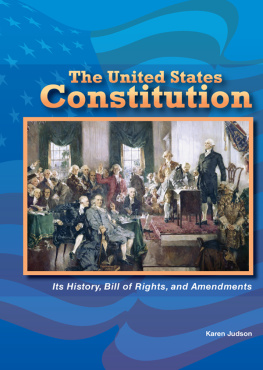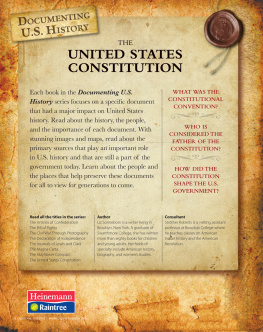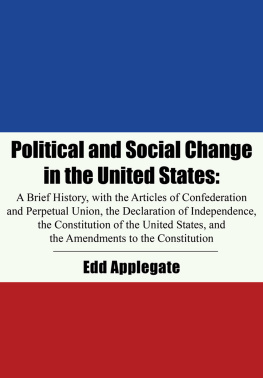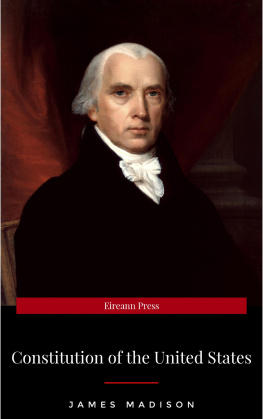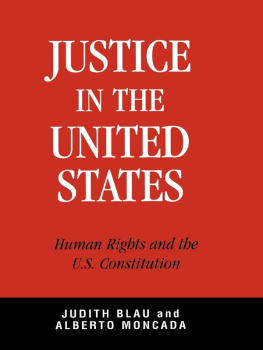Karen Judson - The United States Constitution. Its History, Bill of Rights, and Amendments
Here you can read online Karen Judson - The United States Constitution. Its History, Bill of Rights, and Amendments full text of the book (entire story) in english for free. Download pdf and epub, get meaning, cover and reviews about this ebook. year: 2013, publisher: Enslow Publishers, genre: Politics. Description of the work, (preface) as well as reviews are available. Best literature library LitArk.com created for fans of good reading and offers a wide selection of genres:
Romance novel
Science fiction
Adventure
Detective
Science
History
Home and family
Prose
Art
Politics
Computer
Non-fiction
Religion
Business
Children
Humor
Choose a favorite category and find really read worthwhile books. Enjoy immersion in the world of imagination, feel the emotions of the characters or learn something new for yourself, make an fascinating discovery.
- Book:The United States Constitution. Its History, Bill of Rights, and Amendments
- Author:
- Publisher:Enslow Publishers
- Genre:
- Year:2013
- Rating:3 / 5
- Favourites:Add to favourites
- Your mark:
- 60
- 1
- 2
- 3
- 4
- 5
The United States Constitution. Its History, Bill of Rights, and Amendments: summary, description and annotation
We offer to read an annotation, description, summary or preface (depends on what the author of the book "The United States Constitution. Its History, Bill of Rights, and Amendments" wrote himself). If you haven't found the necessary information about the book — write in the comments, we will try to find it.
Learn about the history and the events that led to first Constitution of the United States, and how its been revised and amended since then.
Karen Judson: author's other books
Who wrote The United States Constitution. Its History, Bill of Rights, and Amendments? Find out the surname, the name of the author of the book and a list of all author's works by series.
The United States Constitution. Its History, Bill of Rights, and Amendments — read online for free the complete book (whole text) full work
Below is the text of the book, divided by pages. System saving the place of the last page read, allows you to conveniently read the book "The United States Constitution. Its History, Bill of Rights, and Amendments" online for free, without having to search again every time where you left off. Put a bookmark, and you can go to the page where you finished reading at any time.
Font size:
Interval:
Bookmark:

We the People of the United States, in order to form a more perfect Union,do ordain and establish this Constitution for the United States of America.
Since its adoption on September 17, 1787, the Constitution has been the supreme law of the United States. Created by fifty-five delegates at the Constitutional Convention in Philadelphia, this document defines the roles and responsibilities of the federal and state governments as well as the rights of United States citizens. Throughout the years, the interpretation of the Constitution has varied to accommodate the needs and changes in our country. Amendments to the Constitution have been made, and sometimes repealed, throughout the years.
About the Author
Karen Judson is a freelance writer who has written on many topics of interest to young people. Most recently for Enslow Publishers, Inc., she has written Abraham Lincoln: This Nation Shall Have a New Birth of Freedom, Revised Edition and The Presidency of the United States.
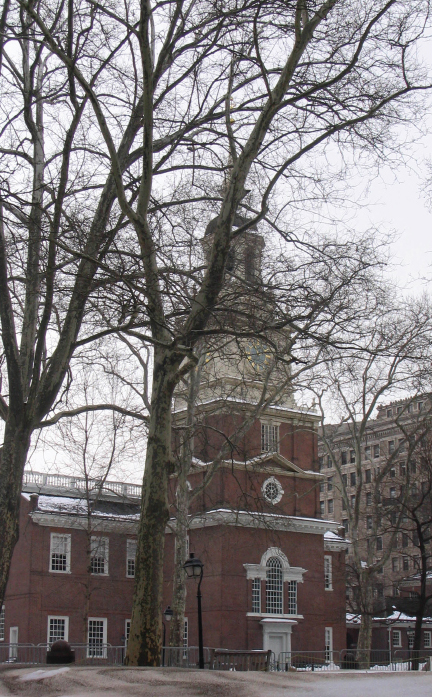
The Pennsylvania State House, now known as Independence Hall, still stands in Philadelphia, Pennsylvania.
By mid-May of 1787, summer had already arrived in Philadelphia, Pennsylvania. The heat and humidity were intense. Mosquitoes and biting black flies swarmed everywhere.
In 1787, Philadelphia was the largest city in America, with a population of 40,000. The eastern seaboard city had been chosen to host the nations first Constitutional Convention. The convention was scheduled to begin May 14. Duly chosen delegates were to arrive from twelve of the thirteen states.
The thirteen states in existence in 1787 were Connecticut, Delaware, Georgia, Maryland, Massachusetts, New Hampshire, New Jersey, New York, North and South Carolina, Pennsylvania, Virginia, and Rhode Island. Twelve states sent delegates to the Constitutional Convention. Rhode Island was the only state to refuse to send delegates; critics said that this was because certain persons in charge of the government profited from the states practice of issuing inflated paper money. This profit might end if the convention was successful in changing the Articles of Confederation.
Few of the convention delegates arrived in Philadelphia by the official May 14 starting date. James Madison arrived first, by stagecoach, on May 3. He brought boxes of books that he had borrowed from his friend Thomas Jefferson. Madison, who liked to be prepared, would study the books after convention meetings adjourned for the day.
George Washington was the second delegate to arrive in Philadelphia. He rode into town in his private carriage on May 13, greeted by cheering crowds and a military honor guard.
Those delegates from Pennsylvania who lived in Philadelphia, including Benjamin Franklin, Jared Ingersoll, and Robert Morris, did not have to travel far to the convention.
The remaining delegates were late for two reasons. Some were also members of the national Congress, which was in session in New York City at the same time that the Constitutional Convention was to begin. Also, travelby horseback, stagecoach, private carriage, or boatwas slow in the best of weather. That years heavy spring rains had muddied dirt roads and flooded streams, adding days to the already long travel times.
By May 25, delegates from seven states had arrivedenough for a quorum, the number of persons needed to conduct business legally. On that date, the Constitutional Convention was officially called to order. The delegates met in the Long Room of the Pennsylvania State House, the same room where the Declaration of Independence had been signed eleven years earlier.
The delegates decided not to release to the public any information about their meetings until the end of the convention. They were concerned that they could not debate freely if others were criticizing or otherwise trying to influence their decisions.
To preserve secrecy, all the windows and doors in the meeting hall were kept closed while the convention was in session. Inside the stuffy room, convention delegates suffered. The men from the northern states sweltered in their heavy woolen suits. Men from the southern states, who were accustomed to the heat, wore lighter clothing, but all the delegates suffered in the powdered wigs, long-sleeved shirts, long suit coats, silk stockings, and knee-length trousers worn by men at that time.
The work of the convention delegates was to revise the Articles of Confederation, which had loosely governed the thirteen American states since 1781. Most states agreed that changes to the Articles were necessary, but opinions varied as to how many and what kind of changes should be made.
Some delegates, including George Washington, Benjamin Franklin, Alexander Hamilton, and James Madison, believed that the Articles of Confederation should be completely discarded. They wanted to create a new constitution that would provide for a strong national government.
Most of the states were against making too many changes to the Articles of Confederation. They were concerned that sweeping revisions to the Articles would create a powerful national government that would rob states of their rights. In fact, the states had made it clear to their delegates that they were not to bargain away states rights. Credentials issued by Delaware to delegates George Read and John Dickinson actually forbade them to agree to any revision of the Articles that denied the small states equal voting rights in a national Congress.
A total of sixty-nine to seventy-four delegates were appointed to the convention. (Historical sources vary in their accounts of the number of delegates chosen.) Fifty-five delegates actually arrived in Philadelphia. Of those, twenty-nine attended every convention session. Most of those who missed sessions did so because of personal and family illness, private business, or service in the national Congress. A few delegates missed sessions because they were bored, or because they disapproved of the new national government under construction.
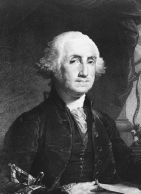
George Washington, who was president of the convention, was one of the older convention delegates.
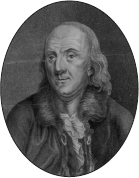
Eighty-one-year old Benjamin Franklin, from Philadelphia, was the oldest delegate to the convention
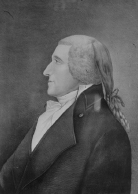
Jonathan Dayton, aNew Jersey delegate, was the youngest delegate to the covention,at twenty-six.
The convention delegates were lawyers, planters, merchants, and professional men. Forty-four of the fifty-five delegates had served or were presently serving in the national Congress. Twenty-one were veterans of the American Revolution against Great Britain. Eight had signed the Declaration of Independence. Six had signed the Articles of Confederation. Two delegatesRoger Sherman of Connecticut and Robert Morris of Pennsylvaniahad signed both the Declaration of Independence and the Articles of Confederation, and would also sign the Constitution.
Next pageFont size:
Interval:
Bookmark:
Similar books «The United States Constitution. Its History, Bill of Rights, and Amendments»
Look at similar books to The United States Constitution. Its History, Bill of Rights, and Amendments. We have selected literature similar in name and meaning in the hope of providing readers with more options to find new, interesting, not yet read works.
Discussion, reviews of the book The United States Constitution. Its History, Bill of Rights, and Amendments and just readers' own opinions. Leave your comments, write what you think about the work, its meaning or the main characters. Specify what exactly you liked and what you didn't like, and why you think so.

